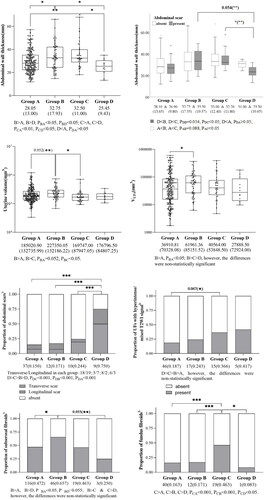Figures & data
Figure 1. CONSORT Flow diagram of the entrollment and data anaylsis of with ufs who suffered the abdominal thermal injury during FUAS.

Figure 2. A 46-year-old woman with UFs but without abdominal scar: (A1) superficial burn (I°) of skin with erythema and edema measuring about 15 cm × 10cm after FUAS immediately; sagittal view of T2WI, (A1) no abnormal signals in the abdominal wall before FUAS; (A3) hyperintense signals after FUAS (indicated by the arrowhead); a 33-year-old woman with UFs and an abdominal scar: (B) superficial partial-thickness burn (S-II°) of skin with blisters measuring about 2 cm × 2cm 1 day after FUAS (indicated by the arrowhead); a 47-year-old woman with UFs but without abdominal scar:(C) deep partial-thickness burn (D-II°) of skin with cheesy, white-to-red appearance measuring about 3 cm × 3cm after FUAS immediately (indicated by the arrowhead); a 31-year-old woman with UFs and an abdominal scar: (D) full-thickness burn (III°) of skin with grayish and wrinkled appearance measuring about 1.5 cm × 1cm after FUAS immediately (indicated by the arrowhead).

Table 1. Patient with UFs suffered skin injury during FUA at different time periods.
Table 2. Univariate analysis of variables associated with thermal injury.
Table 3. Multivariable binary logistic regression analysis to evaluate the correlation of thermal injury with the significant patient characteristics of univariate analysis.
Table 4. Multivariable binary logistic regression analysis to evaluate the correlation of the thermal injury with the significant treatment parameters according to univariate analysis.
Table 5. Evaluation of the relationship between the degree of thermal injury and patient characteristics/treatment parameters according to Kruskal-wallis test.
Data availability statement
The authors support data transparency.


